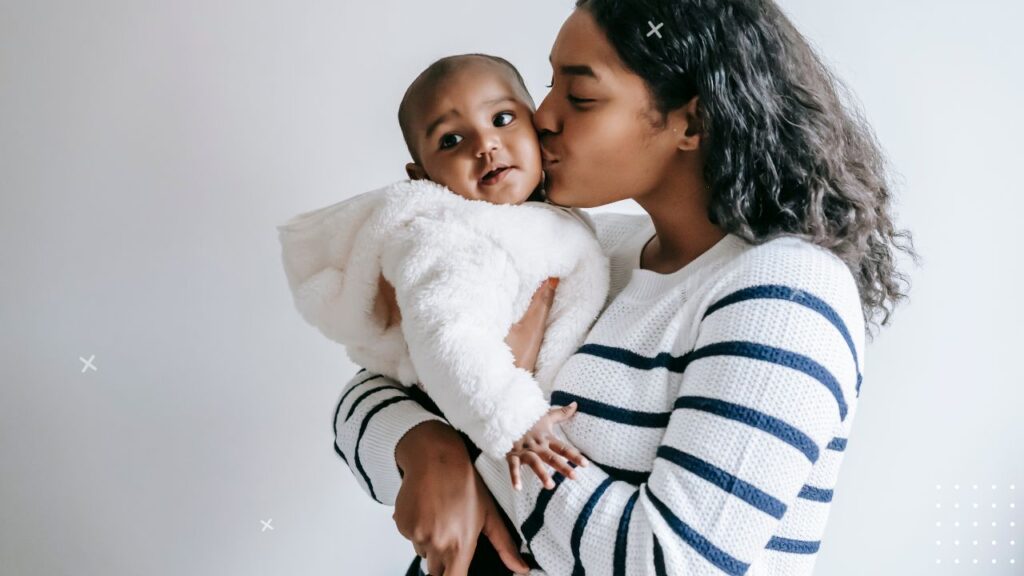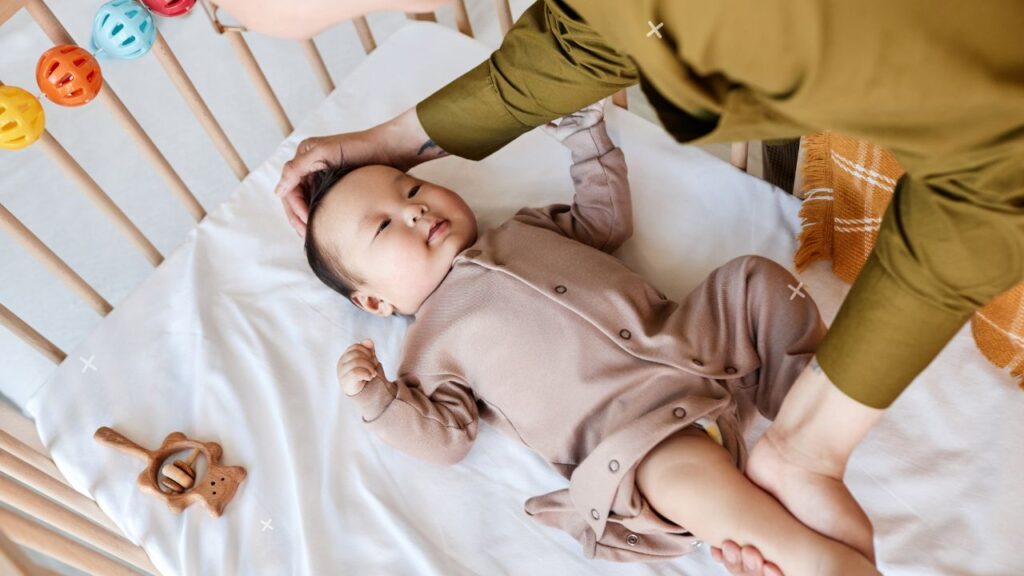As a parent, few things are more distressing than when your baby has a fever. The question quickly arises in your mind – should I put socks on baby with fever? You immediately begin questioning every parenting decision — how to dress baby with fever? What’s the ideal time for socks? It’s easy to second-guess yourself.
One of the most common dilemmas that pops up is: should I put socks on my baby with fever? There seems to be conflicting opinions among doctors on whether fever socks help or hurt.
By the end of this article, you’ll have a clear understanding of the pros and cons of using socks to treat your feverish baby. I’ll provide tips on the best times, types of socks, and care considerations to ensure your little one’s comfort.
What Causes Fevers in Babies? And How Can I Prevent Them?
Before diving into whether socks help or hurt baby fever, it’s helpful to understand what causes it and how to minimize risks – especially during peak cold and flu season.
Fevers occur when your baby’s temperature rises above the normal 97.6-100.4°F (36.4-38°C) range. This is part of the immune system’s natural response to fight infection.
Baby fever triggers include:
- Viral or bacterial infections
- Immunization responses
- Teething
- Overheating from heavy clothing
Fevers tend to peak when body temperature elevates in late afternoons/evenings. While every parent wants to prevent misery, low-grade fevers below 102°F actually benefit baby’s health. The elevated temperature combats invading germs.
However, any temperature spiking above 104°F in infants warrants prompt medical care given risk of seizures, dehydration, and breathing issues.
During cold/flu season, focus on prevention by:
- Breastfeeding your baby to transfer protective antibodies
- Keeping hands clean with frequent washing
- Avoiding large crowds when possible
- Asking friends/family with illness to delay visits
- Ensuring baby receives all scheduled vaccines
- Dressing appropriately for weather to avoid overheating/chills
While scary, most baby fevers resolve on their own with attentive care from parents! Know when to call your pediatrician and how to ease discomfort until the storm passes.

Tips for Closely Monitoring Your Baby’s High Temperature
Accurately tracking your baby’s fever patterns is crucial for appropriate treatment. Confirm any suspected fever with a quality thermometer instead of relying on the touch test.
I recommend a versatile 3-in-1 thermometer allowing rectal, oral, and temporal artery temperature taking. This ensures you can monitor fluctuations properly by checking different points.
Here’s a helpful baby fever temperature interpretation reference:
- 100.4°F (38°C) or higher indicates a fever
- 102°F (38.9°C) and up calls for caution
- 104°F in infants under 3 months warrants prompt medical help
Record baby’s temperature readings each time you check. Note the date, time, reading, location taken, and any medication administered. Share this fever log with your pediatrician when consulting about illness – it provides helpful context!
Schedule periodic temperature spot checks depending on severity, even waking sleeping baby to assess downward or upward fever trends. Contact your doctor promptly if concerns arise or high temperatures persist beyond 72 hours without improvement.
| Fever Temperature | Action Needed |
|---|---|
| 100.4°F – 102°F (38°C – 38.9°C) | Fever present – continue monitoring and use comfort measures |
| 102°F – 104°F (38.9°C – 40°C) | Moderate fever – call doctor if persists over 72hrs |
| Over 104°F (40°C) | High fever in infant – seek medical attention promptly |
Dressing Your Feverish Baby Appropriately
Determining proper attire for a sick baby whose body is fighting infection can be confusing. Many parents question: how to dress baby with fever?
As a fever indicates an elevated internal body temperature, refrain from bundling them in thick fabrics that trap heat. Instead opt for lightweight, breathable clothing in natural materials like cotton.
Dress baby in loose one-piece outfits allowing air circulation. For extra warmth if shivering, add a single cotton layer such as a swaddle or sleep sack. Footed jammies help keep kicking feet covered.
Consider keeping the thermostat lowered and using only a light blanket to prevent overheating. Feel baby’s torso, feet, and back of the neck checking for unwanted warmth buildup.
The goal is maintaining a comfortably cool climate without reaching chilled or sweaty. Babies lose heat through their head, so ensure their head temperature feels neutral to the touch.
Learning appropriate feverish baby attire takes practice – you’ve got this! Dress in thin layers allowing adjustments as their fragile body fluctuates.
Should I Try Putting Wet Socks on My Baby with Fever?
Among home remedies passed through generations is using wet socks to treat baby congestion and fevers. But does this unconventional approach work?
The premise is that putting cold, wet cotton socks on your baby draws damaging heat away from the vital internal organs. Fever supposedly breaks as temperature regulation kicks in to warm the feet, allowing the body to cool down. There are many parental anecdotes claiming this method succeeds!
However, there’s unfortunately no scientific evidence that wet socks effectively reduce high temperatures. And the American Academy of Pediatrics doesn’t endorse the practice, instead advising medication for comfort.
I suggest trying infant acetaminophen or ibuprofen as recommended by your doctor first. If fever persists despite correct medication dosing, wet socks may provide additional relief.
Gently rub your baby’s feet with a cooled washcloth or give them a lukewarm bath before putting on room temperature cotton socks. Avoid drastic temperature changes. Recheck temperature often and remove socks if temperature drops too rapidly. Use your best parental judgement!

Choosing the Best Time for Socks on Your Feverish Baby
Determining the ideal timing for socks on baby with fever largely depends on delicately tracking their fluctuating temperature patterns.
Fevers often drastically spike in late afternoons through early evenings when body heat peaks. Placing socks during this uptick may help stabilize the rise.
However, temperatures commonly dip overnight as melatonin release initiates sleep. At this point I strongly advise removing any socks to prevent shivering.
Instead check baby’s temperature every few hours, even waking them if necessary to assess sweatiness or chill. Reapply socks when fever rises again based on your child’s needs in the moment.
Adapting interventions to align with body patterns allows ideal targeting of peaks for maximum comfort. Remember – when illness strikes, their relief comes before uninterrupted sleep!
Pick Soft, Breathable Cotton Baby Socks
Baby socks serve as a great fever accessor if used judiciously. But which option works best?
Trusty cotton reigns supreme thanks to its soft, airy feel. The breathable fibers prevent trapping sweat against the skin limiting irritation risks.
I suggest stretchy Burt’s Bees baby socks with smoothing ribbed cuffs. The flexible cotton construction moves with shifting feet. Plus – adorable honeybee patterns provide cheerful flair!
Ensure any socks selected aren’t overly tight, as this can hinder circulation. Toes should freely wiggle without leaving indentations on smooth skin. Newborns especially have sensitive skin prone to damage.
Also consider slightly larger sizing allowing room for swelling which commonly accompanies infection. Remember to take them off periodically for skin checks!
Thoughtfully Consider Circulation & Skin Health Risks of Baby Socks
The medical debate on managing baby fever with socks also weighs blood flow and skin impedance concerns.
Physicians caution that wearing socks redirects blood flow to the feet as the body attempts cooling. This leaves less circulation nourishing the vital upper organs.
For adults, this poses little consequence. But in infants, redirected blood flow could impact body’s carefully balanced oxygen/nutrient delivery system.
Additionally, some doctors warn keeping sweaty socks on may overhydrate baby’s skin, raising irritation risks. However pure breathable cotton allows ventilation resisting moisture buildup.
While absolutely valid considerations, used judiciously I believe occasional sock use seems reasonably safe under watchful supervision.
Check for skin redness, indentations, color changes or mottling indicating circulation or irritation issues. Discontinue use if any discomfort indicators arise.

Reasons Against Using Socks for Feverish Baby
Some pediatricians strongly oppose managing baby’s fever with socks due to key risks like:
Overheating– Extra insulation paired with already elevated internal heat intensifies warmth past safe ranges. Infants poorly self-regulate body temperature.
Blocking fever response– As mentioned, low-grade fever assists fighting infection through elevated germ-combating temperatures. Blocking this could prolong illness.
These sensible warnings deserve weight when considering home interventions. However used sporadically and aligned carefully to needs, cautious sock use seems reasonably safe. Still air on the side of avoiding and use alternate tactics first!
As parents, we aim to ease all sufferings yet cannot prevent every one. Trust those natural instincts to determine what soothes your child best!
Caring for Your Baby After Fever Breaks
The recovery days after illness subsides are an integral rebound period, especially following high fevers. Build strength through:
Promoting fluids– Offer added breastmilk or electrolyte-balanced pediatric drinks. Avoid dehydration.
Nutrition – Include gentle, nutrient-dense foods like avocado, pureed peas, bone broth.
Probiotics – Discuss pediatric probiotic use to replenish healthy gut flora.
Light dressing – Stick to breathable clothing while avoiding dehydration-provoking sweat.
Fever watches – Note any recurrence signaling incomplete recovery.
Soothing – Provide extra rocking, swaddling, singing to rebuild security.
As toleration improves, introduce usual foods/activities. Support healthy immunities thriving through amplified skin to skin contact and reassured bonding time after sickness interrupts routine.
Your pediatrician can advise on vitamins, teething relief, activity reintroduction, and sickness prevention moving forward.
Final Verdict: Should You Use Socks for Your Feverish Baby?
The medical debate continues on managing baby’s fever with socks. But used conscientiously based on diligently tracked comfort needs, my opinion is yes in moderation:
✔️ Monitor temperature closely
✔️ Remove/reapply socks as fever changes
✔️ Select skin-friendly cotton
✔️ Watch for skin irritation
✔️ Note circulation changes
As parents, we aim to ease discomforts yet cannot prevent every one no matter how hard we try. Provide exceptional care catered to what your parental intuition feels is best for your child!
Trust those natural instincts to nurture your little one back to health. Rest reassured knowing sock use seems reasonably safe when used attentively aligned to baby’s needs. You’ve got this!
FAQ – Should i put socks on baby with fever?
Why do some parents put socks on baby with fever?
Some parents believe that putting socks on baby with fever can help reduce their body temperature and make them feel more comfortable. They may also think that socks can prevent heat loss and keep the baby warm.
What are the risks of putting socks on baby with fever?
Putting socks on baby with fever can have some negative effects, such as:
- Increasing the risk of overheating and dehydration, which can worsen the fever and cause seizures or brain damage.
- Interfering with the natural cooling mechanism of the body, which can prolong the fever and delay recovery.
- Causing skin irritation, rashes, or infections, especially if the socks are wet, dirty, or too tight.
What are the benefits of putting socks on baby with fever?
Putting socks on baby with fever can have some positive effects, such as:
- Providing comfort and soothing to the baby, especially if the socks are soft, clean, and dry.
- Enhancing blood circulation and immune response, which can help fight the infection and lower the fever.
- Preventing cold feet, which can cause shivering and increase the body temperature.
How to put socks on baby with fever safely and effectively?
If you decide to put socks on baby with fever, you should follow some best practices and tips, such as:
- Checking the baby’s temperature regularly and removing the socks if it is above 39°C (102.2°F) or if the baby shows signs of discomfort, sweating, or dehydration.
- Choosing socks that are made of natural, breathable, and absorbent materials, such as cotton or wool, and that fit the baby’s feet well without being too loose or too tight.
- Changing the socks frequently and keeping them clean and dry, especially if the baby has sweaty feet or spills liquids on them.
- Consulting your pediatrician before putting socks on baby with fever, especially if the baby has a serious or chronic medical condition, such as diabetes, eczema, or allergies.
What are some alternatives to putting socks on baby with fever?
If you are not sure about putting socks on baby with fever, you can try some other methods to help your baby feel better, such as:
- Giving the baby plenty of fluids, such as water, breast milk, or oral rehydration solution, to prevent dehydration and flush out toxins.
- Dressing the baby in light, loose-fitting, and comfortable clothing, and avoiding blankets, hats, or gloves, to allow the heat to escape and regulate the body temperature.
- Applying a cool, damp cloth to the baby’s forehead, neck, or armpits, or giving the baby a lukewarm bath, to reduce the fever and soothe the skin.
- Using a humidifier or a vaporizer to add moisture to the air and ease the baby’s breathing and coughing.
- Giving the baby a pain reliever, such as acetaminophen or ibuprofen, as directed by your pediatrician, to lower the fever and relieve the discomfort.











